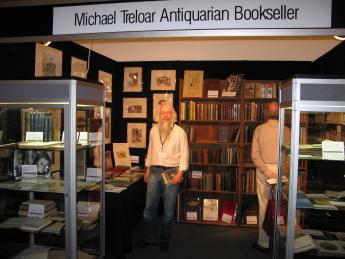The Australian and New Zealand Association of Antiquarian Booksellers Michael Treloar Antiquarian Booksellers
Photographically illustrated Books

By Michael Treloar
Background
It is widely known that in 1839 William Henry Fox Talbot invented the positive-negative system of photography that effectively was the medium until the digital age supplanted it 150 years later. It is less wellknown that from 1852 he concentrated on perfecting his photoglyphic engraving process, the precursor to photogravure, which revolutionized high-quality book illustration and art reproduction from the 1880s. However, for the period around the 1850s-1880s, original paper photographs were mounted in books in an endeavour to achieve superior pictorial content. Fox Talbot had pioneered this with The Pencil of Nature (1844-46), and over the next few decades, a unknown number of books (but reckoned to be only in the midthousands) were illustrated in this manner.
Range
The first book known to be illustrated with original photographs is Photographs of British Algae by Anna Atkins, the first part of which was produced in 1843 in an exceedingly small number. You can cross that one off your list now! The nature of the beast dictates that it is still possible to find works published today that are illustrated with original photographs, but items published in the midto latenineteenth century tend to constitute the primary source material. Many books from this period contain merely a smallformat frontispiece portrait, often in a posthumous biography of some religious or civic worthy, or the outpourings of some amateur poet. However, the best of the genre, often of an expeditionary or ethnographic nature, are key pieces in their respective fields, and rightly command much attention and attract big money.
Availability
Curiously – but happily for the collector – one of the very earliest photographically illustrated books is neither impossible to find, nor massively expensive. The June issue of the journal The Art-Union, published in London in 1846, and most commonly found in bound copies of Volume 8, contains an article on 'The Talbotype – SunPictures'. All 7000 copies of that issue had an original paper photograph mounted in them, and many different images were used. It is well worth aiming to acquire one of these volumes. Of course, some significant or utterly rare (albeit insignificant) items will not turn up in our lifetimes, but many books with original photographs are there to be found merely by looking. I stress 'by looking', not 'by asking', because many a bookseller will frequently not know he has such things on his shelves. Best to keep it that way, I say! The fascination for the collector is that many of these books were produced on the fringe, the uneven output of an active but independent cottage industry. Accordingly, these items sit patiently on booksellers' shelves waiting to be discovered. There is no more level playing field than that! Australian imprints exist from 1864 and there are some wonderful examples – ask us about them.
Price
Volume 8 of The Art-Union can still be had for very low four figures, as indeed can many intrinsically beautiful and important works. Many of the bread-and-butter lines are dear in the low hundreds, and very cheap prices can be paid for items that fly beneath the bookseller's radar. However, such prices do not always imply genuine bargains, and it is fair to say that many of these lesser works will probably never amount to much financially in the long run. But there's a lot to be said for collecting in an area that one can never be entirely priced out of!
Footnote
The recent two-volume work by Mike Parr and Gerry Badger, The Photobook – a History (2004 and 2006) is in the must-have category, and it is cheap at the current retail price. Robert Holden's pioneering work, Photography in Colonial Australia – the Mechanical Eye and the Illustrated Book (1988) should also be acquired while it is still readily available. We have all three in stock. There are two classics of the genre: Gernsheim's Incunabula of British Photographic Literature (1984) and The Truthful Lens by Goldschmidt and Naef (1980). Both are well worth consulting; the former is in all major Australian libraries, and while the latter is distinctly less common, institutional copies can be found. Both also turn up on the open market.
The article by Michael Treloar was first published in the “ANZAAB Aspects of Book Collecting” on www.anzaab.com, and is presented here, with our thanks, by permission of the ANZAAB.
